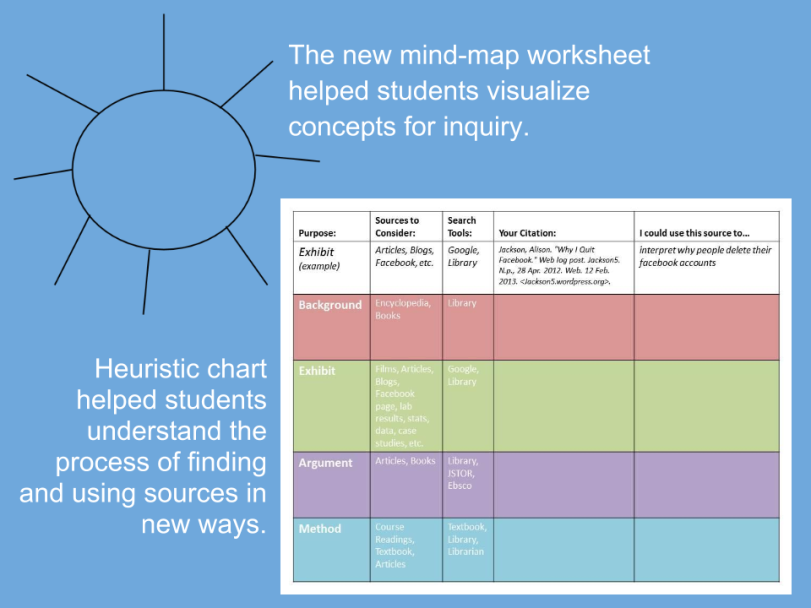The last day of instruction camp was an opportunity for folks to showcase their teaching in a fun and supportive environment and receive peer feedback in order to improve our instruction delivery and mastery of the new content.
Prior to showcasing our teaching I shared recent feedback from an online English 102 class that incorporated our newly designed Research Activity. The new Research Activity connects the BEAM framework to the annotated bibliography assignment.
To encourage the fun, soft balls were brought for folks to tag in and tag out of teaching a concept. Fun tips, mounted on bright colored circles were posted around the room. The showcase was recorded to 1) benefit folks who were unable to attend and 2) give campers the opportunity to play back their teaching and see and hear how they communicate.
This final day of camp was inspirational and uniting. After teaching the first block of the flipped English 102 outline, one camper commented that the recording might be good to provide to students so that they can hear the concept taught by a variety of voices. All campers agreed that it was useful to hear their colleagues teach the blocks as it inspired them to consider new ideas or strategies for presenting concepts. The shared experience of teaching together in order to become better instructors had the unintended outcome of uniting us around our shared goal of improving the research skills of our students.
Here are some specific tips gained from the teaching showcase.
Source Spectrum Block
1. One way you could describe the spectrum is, “This is not a weighted scale. The ends are not binary and do not communicate the value of the sources.”
2. Consider using the source table from Module 2 of the tutorial as an aid or prompt for the students.
3. It is okay to leave ambiguity about sources, i.e. not all sources have to fit on a perfect spot on the spectrum.
4. Let the students determine where the source fits on the spectrum and let them tell you why.
5. If student suggests a source that is not found in a discrete place, like an interview or statistics, ask them, “Where would you find this source?”
BEAM Block
1. Don’t use jargon to describe the framework, e.g. BEAM.
2. Develop a brief, one to two sentence description of the framework that you are confident in delivering.
3. Have your concrete example topics/questions that you will use to talk about the different uses. You could have one example that you use for all four uses or a different example for each use.
4. ‘Argument’ source use can also be described as a source that takes your argument or thesis deeper into more specific analysis.
5. Don’t feel like students have to master the framework before they work with it. You are just introducing it. Give the students time to wrestle with it in their groups and beyond the library instruction session.
Group Task Block
1. Consider asking students what is irrelevant in the research question as opposed to what are the key concepts or search terms. This is an easier question for students to answer (and thus participate!).
2. Consider emphasizing how most of your time will be spent evaluating results not searching, so developing a search strategy will reduce time spent reading irrelevant material.
3. Connect the task of evaluating your results to the BEAM framework.
From my perspective as planner and facilitator of Summer Instruction Camp, I am very impressed by the work of my colleagues and feel that I learned just as much as they did during these intense sessions. Thanks everyone for your hard work!





Nice post! This past spring, I put together a handout on BEAM for my students that seemed to help them develop a more sophisticated understanding of why you need sources in the first place and ways that you can use them in your writing. Feel free to reuse or adapt as needed without attribution.
LikeLike
Thanks, Stephen, for sharing your handout. It looks very helpful. I will share it with my colleagues and our English 102 instructors.
Have you been teaching with BEAM for awhile? How have students responded to this source use framework?
LikeLike
I’ve been teaching it in the library’s credit courses and in the course-related workshops for the past three years. I’m not sure how far it sinks in with the the students in the workshops, but in the credit courses they generally get it (evidence of that can be seen in the annotated bibliography assignment they do as the final project in which they have to indicate how they would likely use that source were they to write a paper on research topic). I first learned about BEAM from my colleagues in the Writing Center, with whom I was co-teaching a year-long series of workshops for students writing undergraduate honors theses; in those workshops, I can definitely attest the the value that the students found in the model and the way they embraced it in their own writing.
LikeLike